Dynamic laser beam shaping by means of a deformable mirror to tailor microstructure in Directed Energy Deposition
IF 6.7
2区 材料科学
Q1 ENGINEERING, INDUSTRIAL
Journal of Materials Processing Technology
Pub Date : 2025-03-20
DOI:10.1016/j.jmatprotec.2025.118797
引用次数: 0
Abstract
In Laser-based Direct Energy Deposition (DED-L), the resultant mechanical properties depend on thermal cycles during deposition. Traditionally these cycles are usually optimized by tuning the laser power, traverse speed of the laser beam or material feed rate. By adapting, in real-time, the spatial power density distribution (intensity profile) in the focal spot of the laser beam, thermal cycles and thus the microstructure can be further tailored during processing. In this paper, a developed dynamic beam shaping setup, based on a deformable mirror, is used to deposit single tracks, where the high power laser intensity distribution is adapted during deposition. Melt pool monitoring showed that this setup allows to significantly change melt pool morphology during deposition. Next, microstructure analysis (EBSD) of the deposited track shows that various microstructures can be achieved, ranging from a track with larger equiaxed grains in the centre and columnar grains at the bottom and sides of the track to equiaxed grains with a strong crystallographic texture throughout the track. This proofs that the dynamic beam shaping setup is a powerful tool to steer the microstructure and therefore the functional properties of the material.

利用可变形反射镜对定向能沉积中微结构进行动态激光束整形
在激光直接能量沉积(d - l)中,沉积过程中的热循环决定了材料的力学性能。传统上,这些周期通常通过调整激光功率、激光束的遍历速度或材料进给速度来优化。通过实时调整激光束焦点光斑的空间功率密度分布(强度分布)、热循环,从而在加工过程中进一步定制微观结构。本文提出了一种基于可变形反射镜的动态光束整形装置,用于单轨迹的沉积,在沉积过程中适应了高功率激光强度分布。熔池监测表明,这种设置允许在沉积过程中显著改变熔池形态。其次,对沉积轨道的微观结构分析(EBSD)表明,可以实现各种微观结构,从中心具有较大的等轴晶粒,底部和侧面具有柱状晶粒,到整个轨道具有强烈的晶体结构。这证明了动态梁整形装置是一个强大的工具,以引导微观结构,从而材料的功能特性。
本文章由计算机程序翻译,如有差异,请以英文原文为准。
求助全文
约1分钟内获得全文
求助全文
来源期刊

Journal of Materials Processing Technology
工程技术-材料科学:综合
CiteScore
12.60
自引率
4.80%
发文量
403
审稿时长
29 days
期刊介绍:
The Journal of Materials Processing Technology covers the processing techniques used in manufacturing components from metals and other materials. The journal aims to publish full research papers of original, significant and rigorous work and so to contribute to increased production efficiency and improved component performance.
Areas of interest to the journal include:
• Casting, forming and machining
• Additive processing and joining technologies
• The evolution of material properties under the specific conditions met in manufacturing processes
• Surface engineering when it relates specifically to a manufacturing process
• Design and behavior of equipment and tools.
 求助内容:
求助内容: 应助结果提醒方式:
应助结果提醒方式:


